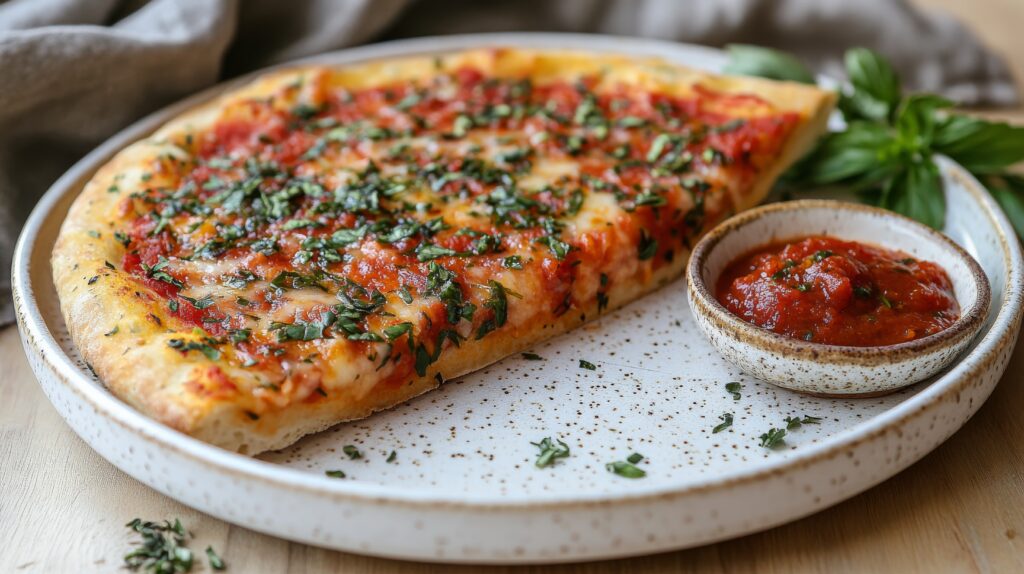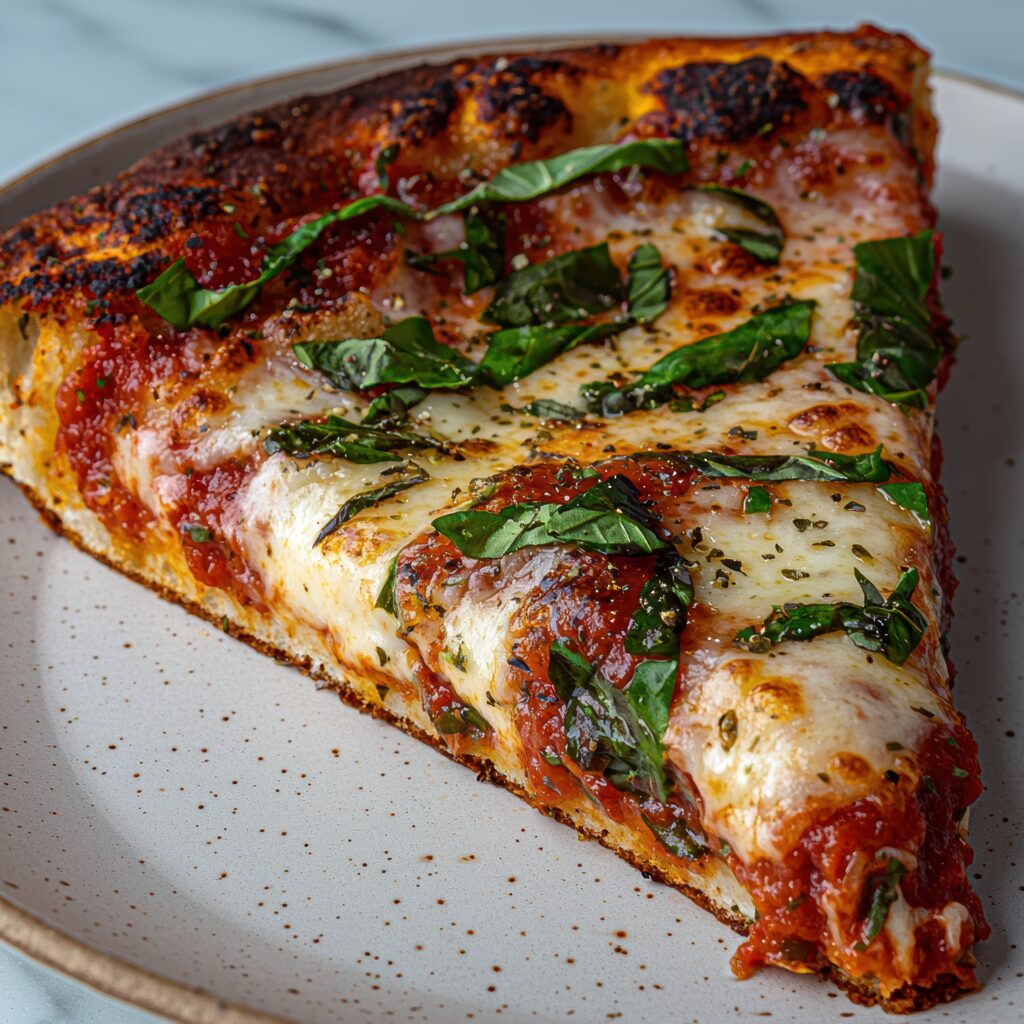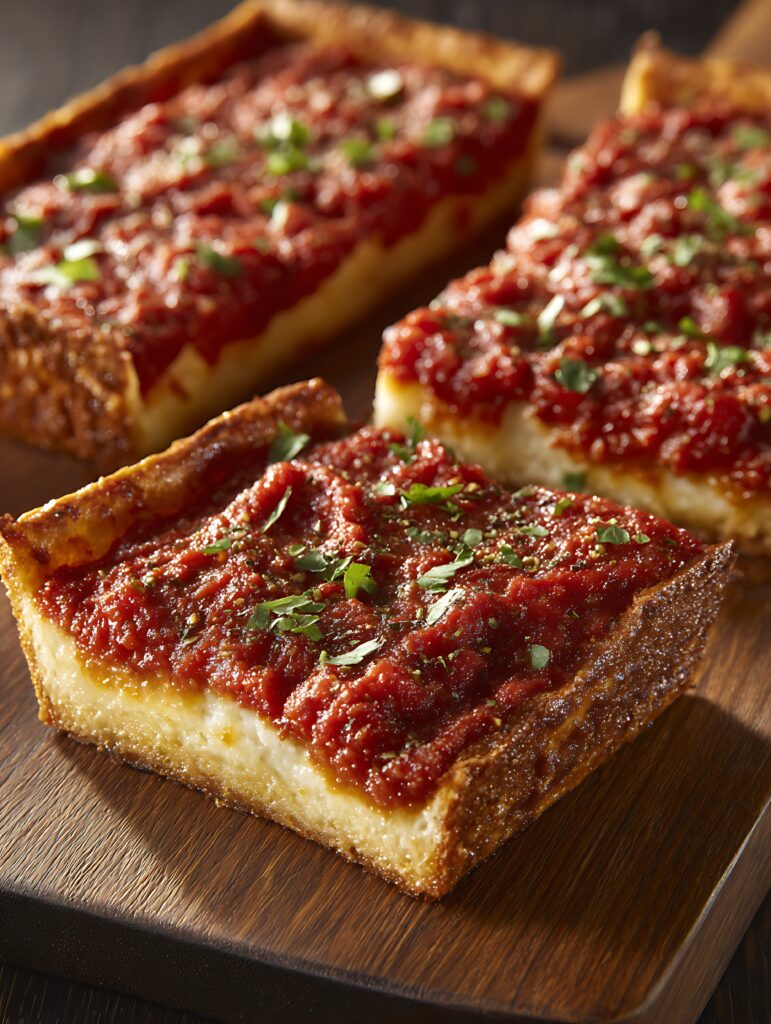
A Slice of Home on a White Plate
Imagine sitting at your table, a crisp white plate placed before you. Resting on it is a bright, colorful pizza: rich tomato sauce, melty mozzarella, and fresh basil leaves delicately laid across the top. The colors—red, white, and green—pop beautifully against the plain background, making each ingredient feel special.
This isn’t a heavy, complex pizza. It’s humble. It’s fresh. And every bite tastes like sunshine in your kitchen. This classic style of pizza is known as Pizza Margherita—a timeless favorite born in Naples, Italy, and loved around the globe for its simplicity and grace.
Why This Pizza Feels So Right
Table of Contents
- Fresh and simple ingredients: Just dough, tomato sauce, mozzarella, basil, and a drizzle of olive oil.
- Vibrant colors that look like Italy’s flag—making it visually stunning and instantly appetizing.
- Tastes pure and honest: No heavy layers, no distractions—just tomato brightness, creamy cheese, and aromatic basil.
- Easy to make, joyful to eat: Great for everyone—from home cooks to pizza lovers looking for authenticity.
A Bit of History
This pizza is said to have been created in 1889 by a Neapolitan pizzaiolo named Raffaele Esposito, who made a special pizza to honor Queen Margherita of Savoy. He used tomato, mozzarella, and basil to mimic the Italian flag. After the queen enjoyed it, the pizza was named in her honor. Though similar pizzas existed earlier, this version popularized the name and the symbolic ingredients Norecipes – Elevating Everyday .
What You’ll Need (Serves 2–4)
- Pizza dough (homemade or store‑bought; room temperature)
- Tomato sauce (simple crushed tomatoes seasoned lightly)
- Fresh mozzarella cheese, torn or sliced
- Fresh basil leaves, whole or torn
- Extra‑virgin olive oil, for drizzling
- A pinch of salt and pepper (optional)
These ingredients are few—but pick quality ones. Good sauce, fresh basil, and creamy mozzarella make a huge difference.
How to Make It: Step by Step
1. Preheat Your Oven
Set your oven as high as it will go—ideally around 475–500 °F (240–260 °C). If you have a pizza stone or steel, preheat it in the oven—it helps create a nicely charred crust.
2. Shape the Dough
Dust your surface lightly with flour or semolina. Stretch or roll your dough into a round, about 10–12 inches wide, leaving a small raised edge for crust.
3. Add Sauce & Cheese
Spread a thin layer of tomato sauce evenly, stopping just before the edge. Avoid over‑saucing. Then gently place pieces of torn mozzarella over the sauce in a scattered pattern.
4. Bake Until Golden
Slide the pizza onto your stone or baking sheet. Bake for 8–12 minutes—you want the crust to puff and turn golden, and the cheese to bubble and soften.
5. Finish with Fresh Basil & Oil
Once out of the oven, immediately top with fresh basil leaves. Drizzle extra‑virgin olive oil, and season with a pinch of salt or pepper if you like. The heat wilts basil just enough to release fragrance—but raw basil keeps its vibrant green and herbal punch.
6. Slice & Serve
Place it on a white plate—the clean background makes the pizza look like a work of art. Slice into wedges, pass around, and enjoy while hot.
Taste and Texture Notes
- Crust: thin and crisp with gentle chew, toasted golden.
- Tomato sauce: clean, slightly tangy, almost sweet.
- Mozzarella: full‑flavored, creamy, melty without overwhelming.
- Basil: fresh, bright, herbal lift.
- Olive oil: smooth, fruity richness that ties everything together.
Serving Suggestions
- Pair with a light green salad dressed with lemon and olive oil.
- Serve with a cold drink—sparkling water with lemon or a crisp white wine.
- Offer extra basil, grated cheese, or chili flakes at the table for guests to add.
Pro Tips for Perfection
- Use San Marzano tomatoes for sauce when possible—they taste natural and fresh.
- Fresh basil last—never bake with basil, as it loses its color and aroma.
- Dry fresh mozzarella before topping to avoid sogginess.
- High oven heat creates optimal crust and bubbling.
- Let pizza rest 1–2 minutes after baking—the cheese settles and slices cleanly.
Variations & Creative Ideas
- Add a few sliced cherry tomatoes or roasted tomato pieces before baking for a pop of freshness.
- Sprinkle Parmesan or Pecorino before serving for nutty depth.
- Brush the crust edge with olive oil or garlic butter as soon as it’s out of the oven for extra flavor and shine.
- Thin crust or thick crust, whatever you prefer—the important thing is balance and simplicity.
Cultural Roots & Italian Spirit
Pizza Margherita originated as a symbol of Italian unity and culinary pride, reflecting the green, white, and red of the national flag. While stories about Queen Margherita helped cement the name, pizzas with tomato and basil had existed in Naples even earlier in the 1800s.
Why It Feels Like Home
Every element of this pizza gives you comfort: warm dough, gooey cheese, fresh herbs, and tangy tomatoes. It doesn’t need elaborate ingredients or steps. It’s honest and satisfying—a perfect dish for sharing, for quiet dinners, or for feeling connected to a timeless Italian tradition.
Quick Reference Summary
| Step | What to Do |
|---|---|
| Preheat oven | 475–500 °F, pizza stone inside |
| Shape dough | 10–12″ round with a small crust edge |
| Add sauce & cheese | Thin tomato sauce, scattered mozzarella |
| Bake | 8–12 min until crust golden and cheese bubbly |
| Add basil & oil | After baking, fresh basil and olive oil |
| Serve | On white plate, slice immediately |
Final Thought

This Pizza Margherita—simple tomato sauce, melted cheese, and fresh basil—is more than food. It’s memory and heritage on a plate. Served beautifully on a white plate, it’s both humble and elegant.
You’ll love it because it’s easy to make, beautiful to see, and joyful to eat. It’s proof that food can be both art and heart: clear, honest, and full of flavor.
So gather your ingredients, heat your oven, and discover how simple can be sensational. Buon appetito!
Try this today also:
Chicago Deep‑Dish Pizza

